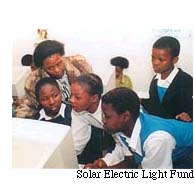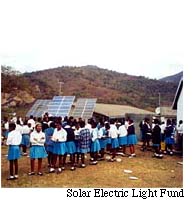|

SEP 09, 2001
Solar Power Is Reaching
Where Wires Can't
By DAVID LIPSCHULTZ
Two hours outside Durban, South Africa, deep in the Valley
of a Thousand Hills, Myeka High School had no electricity. Students
struggled to read by candlelight, and few textbooks and newspapers
were available. The school was clearly having a hard time doing
its job: only 30 percent of the students graduated, and even
those had little hope of going beyond their isolated village.
Then, in the spring of last year, solar energy came to town.
Photovoltaic solar panels, firing up 2.4 kilowatts of power,
were brought into the school by the Solar Electric Light Fund,
a nonprofit group based in Washington. SELF also persuaded Dell
Computer and Infosat Telecommunications to donate computers and
a satellite uplink so that the students could have Internet access.
Now that the students can download materials from the Internet
and have access to the Learning Channel, the graduation rate
has shot up to 70 percent. Some students have won science awards,
and many are applying for college. "I never thought the
sun could do all this," said Melusi Zwane, the school's
principal.
 Myeka is a vivid example of
the impact of computers on society. But what makes this tale
stand out is the arrival of solar power. "It's the reason
for all that we have now," Mr. Zwane said. "Everything
comes from power." Myeka is a vivid example of
the impact of computers on society. But what makes this tale
stand out is the arrival of solar power. "It's the reason
for all that we have now," Mr. Zwane said. "Everything
comes from power."
Business has long been keenly aware of the potential of providing
energy to deprived areas. And interest in narrowing the world's
much-discussed digital divide, between the connected and the
unconnected, has only made the opportunity more inviting.
That is why energy projects like the one at Myeka High School
are not solely philanthropic. Though many financing hurdles remain,
there is money to be made, especially for solar energy companies,
when markets like these go online.
In fact, according to Strategies Unlimited, a market research
firm in Mountain View, Calif., for the solar industry, roughly
40 percent, or $1.2 billion, of the $3 billion worldwide solar
business last year came from rural markets like the Valley of
a Thousand Hills. In the United States, for example, solar has
had decent sales as an environmentally friendly complement to
the existing power grid, but there is a more immediate need for
it in rural areas. Strategies Unlimited predicts that the leading
companies in the industry, like the Royal Dutch/Shell Group,
Siemens, BP, Sanyo Electric, Sharp, Kyocera and AstroPower, will
continue to have revenue growth of about 20 percent a year from
these markets. That will make the remote rural market alone worth
roughly $2.5 billion by 2005.
Two billion people, roughly 30 percent of the world population,
are off the energy grid, living in areas without utility services.
And a billion of them have the means to pay for power, said Prof.
Daniel M. Kammen, director of the Renewable and Appropriate Energy
Laboratory at the University of California at Berkeley.
According to solar industry vendors and analysts, many of
these billion people spend $5 to $10 a month on kerosene, almost
exclusively for lights. Solar power, of course, has many more
uses, and by amortizing the start-up costs over perhaps five
years, the total cash outlay is about the same.
"There's a lot of money to be made in converting those
people to solar," said Dr. Allen M. Barnett, chief executive
of AstroPower, a publicly traded company based in Newark.
In July, for example, Shell Solar signed an agreement with
the Sun Oasis Company, a distributor in Beijing, to supply systems
for up to 78,000 households in rural western China.
Aside from selling directly to remote areas, solar energy
companies are expected to achieve much of their growth in powering
telecommunications companies that want to extend their services,
including the Internet.
"In some cases the economics involving off-grid power,
such as power generators, don't allow telecom carriers to go
further out," said David Dunsworth, director for power systems
of Hutton Communications, a Dallas-based distributor of telecommunications
equipment. "Solar allows them to do it."
Robert A. Freling, executive director of SELF, said, "There's
no question that telecommunications and computer availability
are major issues when trying to get communities online, but without
energy you can't even talk about those."
Solar power has become the energy of choice in many rural
markets, in large part because the price has dropped considerably
in the last few years. Prorating over roughly 10 years, the upfront
cost of solar panels and accompanying batteries gives the energy
a cost of roughly 18 cents a kilowatt-hour, competitive with
any off-grid power.
 Moreover, solar energy has no moving parts,
unlike other renewable sources, including wind and hydro, which
makes it easy to maintain in areas where technicians are hard
to find. Moreover, solar energy has no moving parts,
unlike other renewable sources, including wind and hydro, which
makes it easy to maintain in areas where technicians are hard
to find.
Solar power's attractiveness off the grid, and an overall
interest among governments, corporations and international organizations
in bridging the digital divide, have put it in a sweet spot.
"I think getting people online in rural areas will be
a huge growth driver going forward for local solar companies,"
said Steve Cunningham, an investment officer for the Energy House
Capital Corporation of Bloomfield, N.J., one of several private
American equity firms that have millions of dollars to invest
in energy companies in rural markets in the developing world.
But big challenges remain. Though they can last for 20 years,
solar panels and batteries cost a minimum of $500 for a small
house. That would be a huge upfront payment for many people,
said Charles Gay, a director of Greenstar, a nonprofit group
based in Los Angeles that promotes the use of solar energy in
bringing remote areas online.
"Coming up with a viable financing arrangement is definitely
one of the biggest challenges," Mr. Barnett of AstroPower
said.
International organizations like the World Bank and the United
Nations Development Program have started to put money into projects,
and businesses, to help solve the financing problem.
Two years ago, the International Finance Corporation, the
private investment arm of the World Bank, began investing $30
million through its Photovoltaic Market Transformation Initiative
for solar projects in developing countries like India and Morocco.
But some people contend that even though these projects provide
power for remote areas, many people in those areas have more
pressing priorities than spending their scarce dollars on computers
and Internet access.
"Clearly, for those numerous people in the developing
world that are hungry or sick, food and health must take priority
over everything, even education," said Lester Brown, chairman
of the Worldwatch Institute in Washington.
But many people who are involved in solar projects say the
access to power can help deal with those issues, too.
In some remote villages, the economy is "a barter system
where they exchange crops for kerosene, kerosene for medicine
and things like that," Mr. Gay said. "You have to give
them the resources to transform themselves into a real currency-earning
society."
In Parvathapur, a remote village in south- central India that
is off the power grid, Greenstar is starting to find evidence
of that. Last year, Greenstar invested about $75,000 in solar
panels, computers and Internet access to provide the village
with money-generating tools.
The village now sells its music, art and calendars online
to customers who include expatriate Indians in the United States.
Fifty-five percent of the revenue now goes to Greenstar to pay
back the initial solar and infrastructure expenditure. "Within
four years, we expect to have recovered our investment,"
Mr. Gay said.
Once the money is paid back, Greenstar's share will fall to
10 percent, which will go toward financing other projects in
places like Jamaica, Ghana and the West Bank or future ones in
Brazil and Tibet. "It's a self- replicating finance mechanism,"
he said.
In return, villages like Parvathapur receive not only a way
to build a micro- economy for their music and arts products,
but also a tool to better support their principal source of income,
agriculture.
Mr. Gay said the village is using the Internet to learn the
most efficient times to plant and harvest crops and the best
markets in which to sell them. "The village is making more
money than before," he said.
Over the last two years, with a similar goal in mind, the
Grameen Bank has financed more than 30 rural communities in Bangladesh
for energy projects. It gives interest-bearing loans to people
in those areas to buy Internet connectivity products like solar
panels and phone equipment. Enough entrepreneurial activity has
emerged to achieve a 90 percent payback rate on the loans.
SELF has provided revolving-credit loans to various areas
for home lighting. When it comes to projects with fully integrated
Internet access, SELF relies on grants and does not have a specific
repayment plan. It says it hopes that some type of commerce arises
from the efforts.
Building such commerce appears crucial. Many vendors and project
managers agree that if a village cannot set up a business model
and generate enough income from the new energy and the Internet
access, it will eventually be in the dark again.
"I've seen it many times," Mr. Gay said. "If
the community isn't self-sustaining after a while, none of this
will work."
Copyright
2001 The New York Times Company
The online URL for this story (which requires free
registration with The Times) is
http://www.nytimes.com/2001/09/09/business/09SOLA.html
click here
to download a printable copy of this document
|

